ChristoJ
Superclocked Member

- Total Posts : 225
- Reward points : 0
- Joined: 2011/03/06 11:57:36
- Status: offline
- Ribbons : 1


In another thread we were talking about possible application methods of TIM when you have lapped your CPU and Block to a mirror shine so I put some of the most common ideas to the test with two plates of glass. Glass: 4" square for size reference TIM: An ungodly combination of Dynex Ceramic and Tuniq MX-4 (that ended up getting shipped ot me too hard to use) After each application the glass was cleaned with cotton and Iso, and dusted with a coffee filter. Now to the Fun stuff Rice Grain Application Quantity Reference 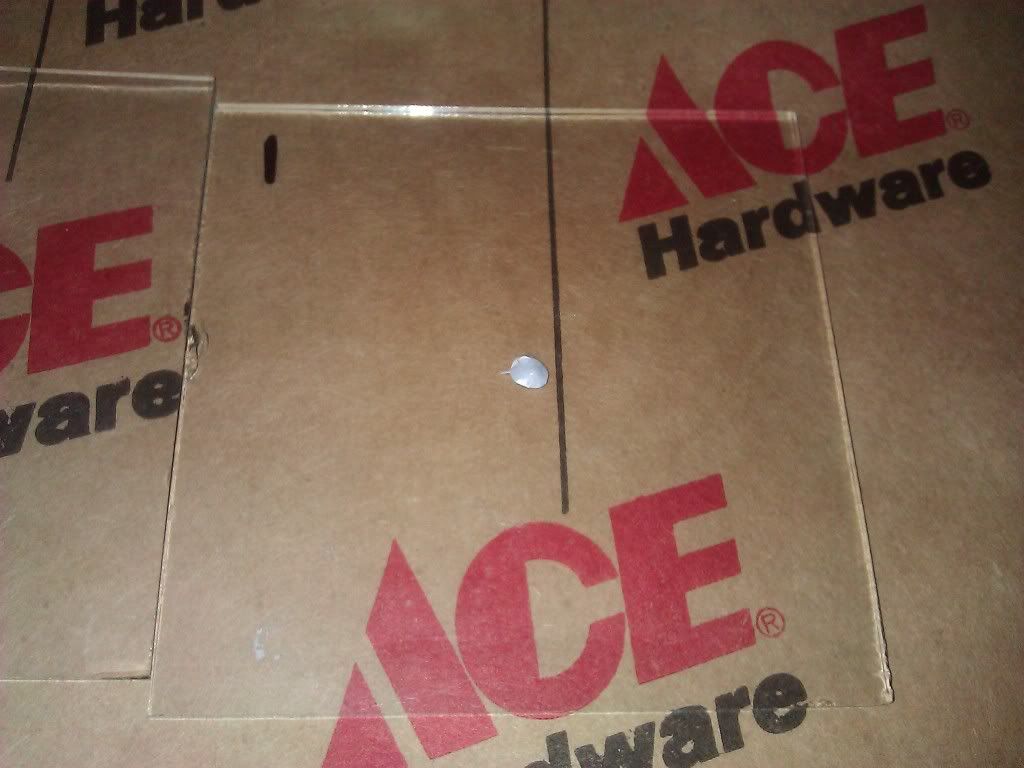 Video of joining the two pieces Spread-Out Both Sides Video of joining the two pieces Spread-Out Both Sides 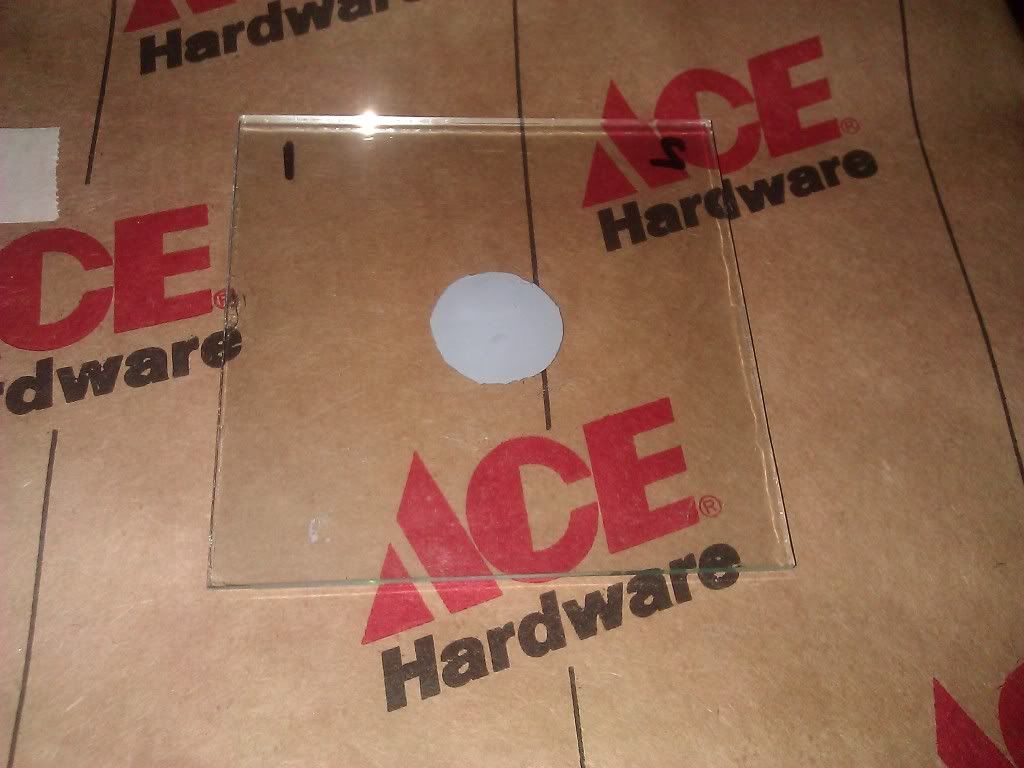 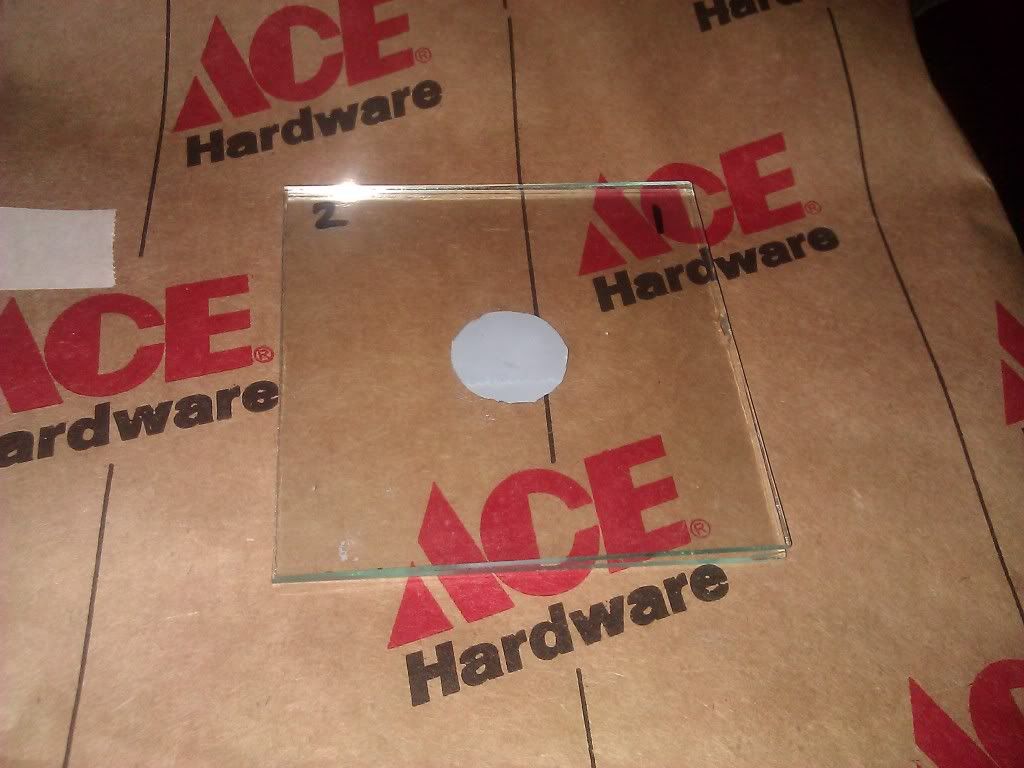 While the rice grain method is one of the highest praised methods I did find one flaw with it. On the good side the rice grain method provides you with the thinnest layer of TIM but it will leave alot of uncovered real estate. I will have to admit though, in my opinion this definately worked the best for the simulated lapped CPU and HSB. Regardless though, this would be enough to fully cover the die on any CPU. Only if there was a way to really get a volume needed for maximum coverage vs layer thickness. Also, through heat and over time I would imagine this would spread out a little more (dependent on TIM). I tell how thin the layer of TIM was because as I twisted the glass I could feel the glass begin to tighten up and create a vaccuum (like if you put a single drop of water between two pieces of glass they are hard to seperate) Pea Size Method Quantity reference 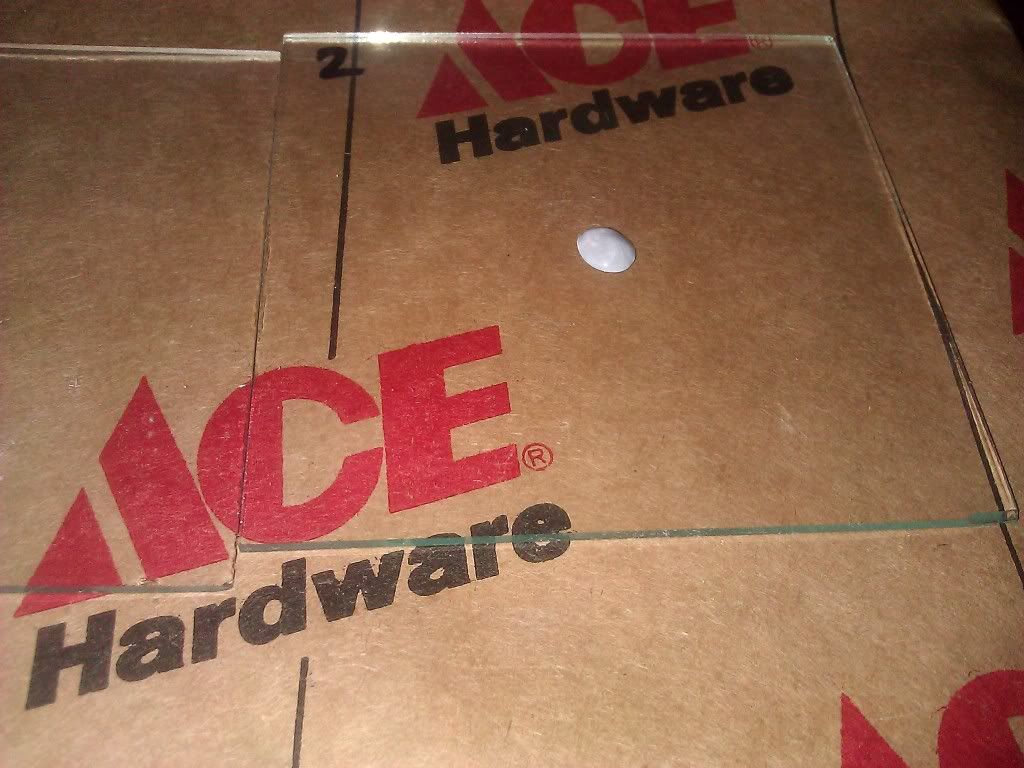 Video of Joining the Two Pieces Spread-Out Both Sides Video of Joining the Two Pieces Spread-Out Both Sides 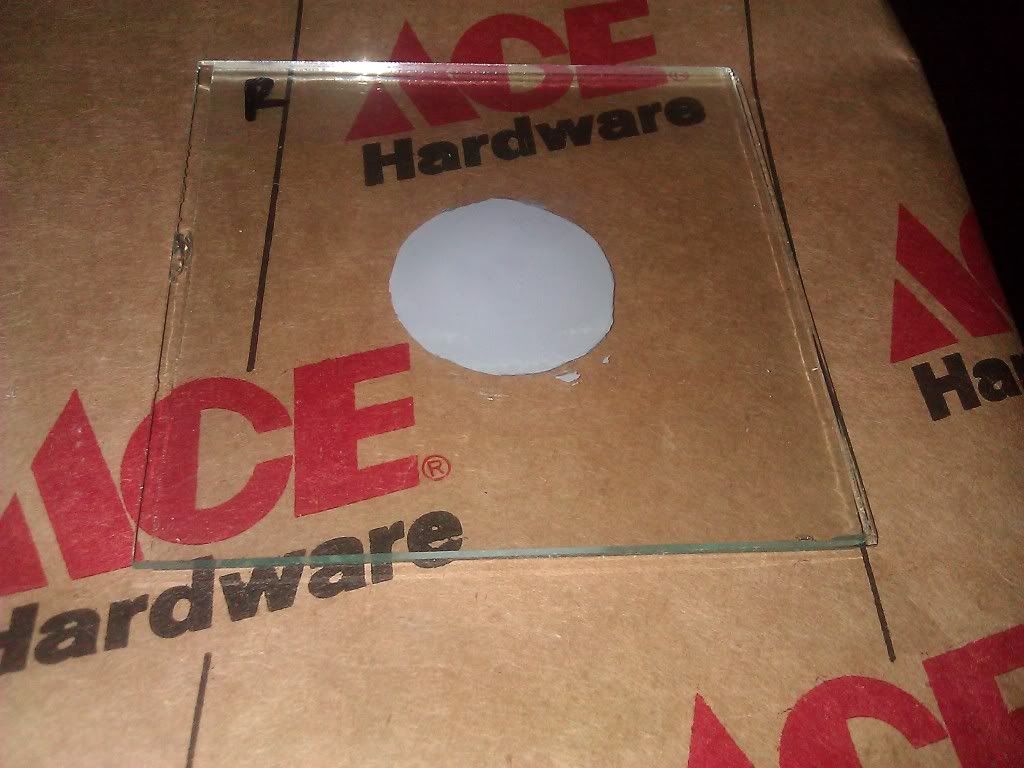 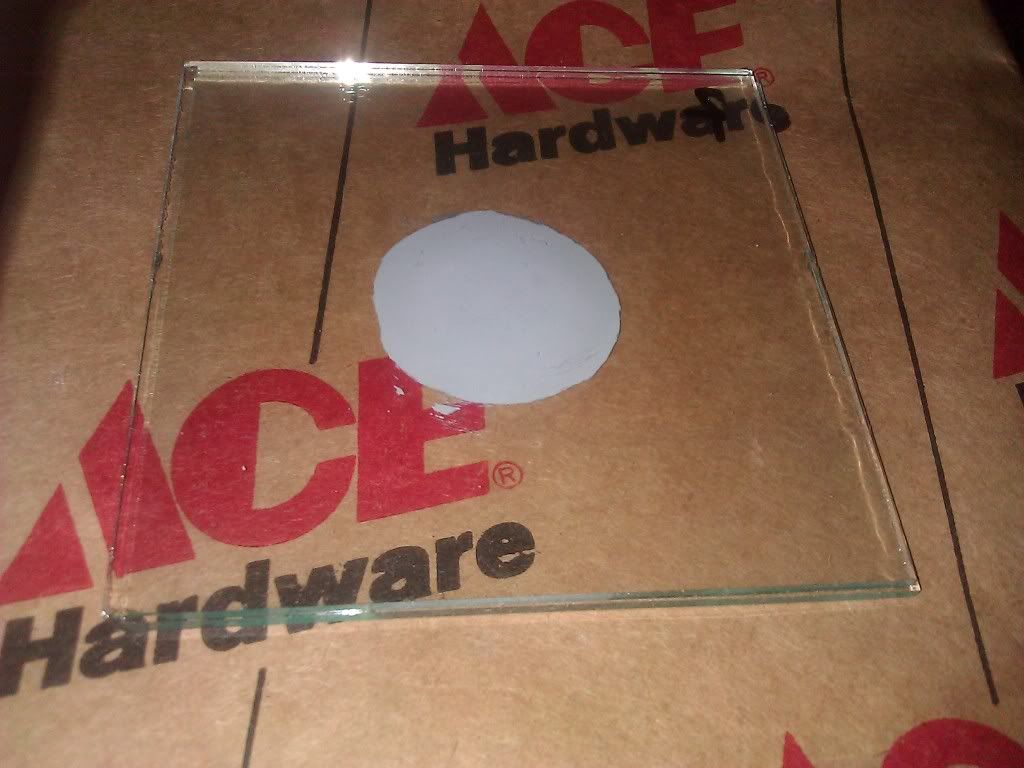 While i really liked this method, I used just a bit too much. Great coverage; if this was on any LGA Intel chip it would nearly cover the entire IHS. This method would probably be the better if not best choice for AMD Chips. Reasoning behind that is that like I said, I think I used just a little too much TIM as I could feel the glass begin to tighten up but I could still tell a significant difference in the feel and thickness of the layer of TIM. This could/would spread out over time though. Single Line Application Quantity reference 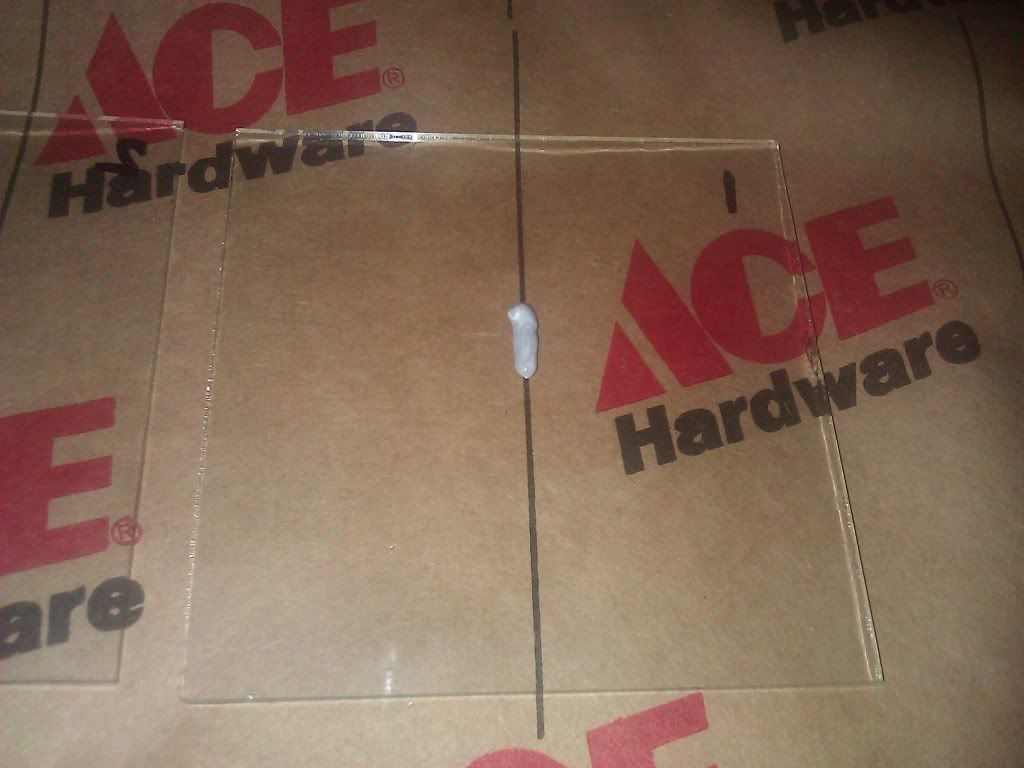 Video of Joining the two pieces Spread-Out both sides Video of Joining the two pieces Spread-Out both sides 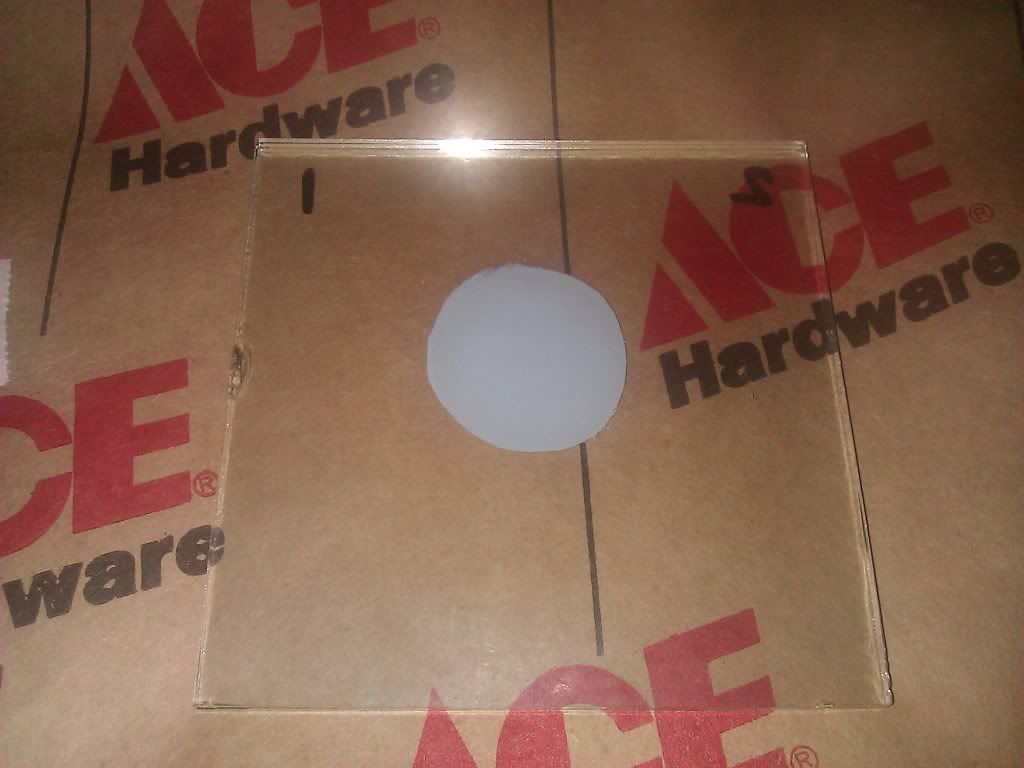 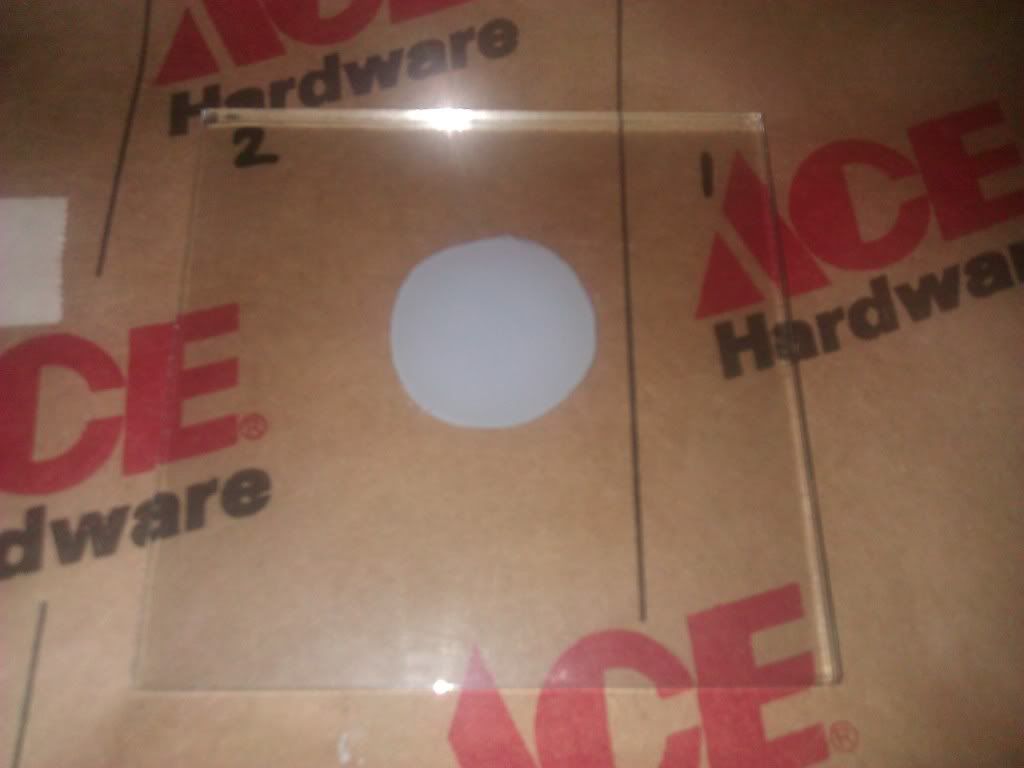 This method is reccomended by Intel at the least, and while I did have some decent success with this method I would not reccomend this method for someone who has lapped their equipment to a mirror shine. If you have just lapped your equipment flat this could work very well as there would be enough TIM to fill in all of the gaps left in the metal by rougher sandpapers. Again in this case there is just too much TIM, very slick, almost no tightening and definately not thin enough layer for mirrored equipment. At this level I can visibly see a seperation in the glass at the edges. Double Line Method Quantity Reference 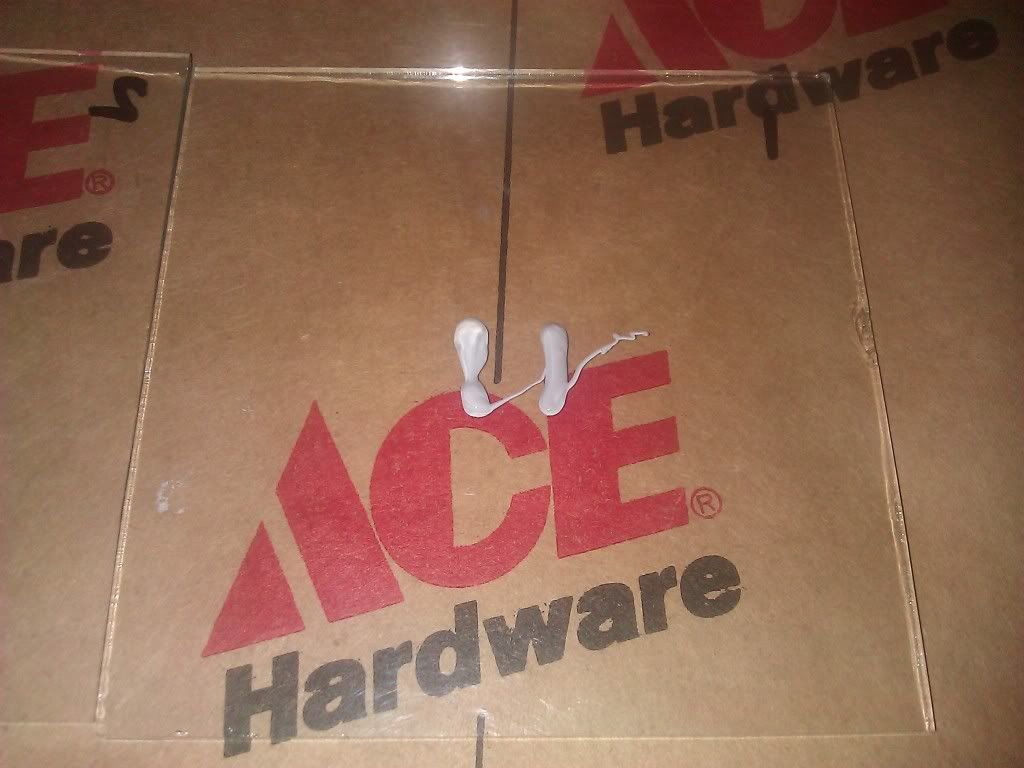 Video of joining the two pieces Video of joining the two pieces Spread out both sides 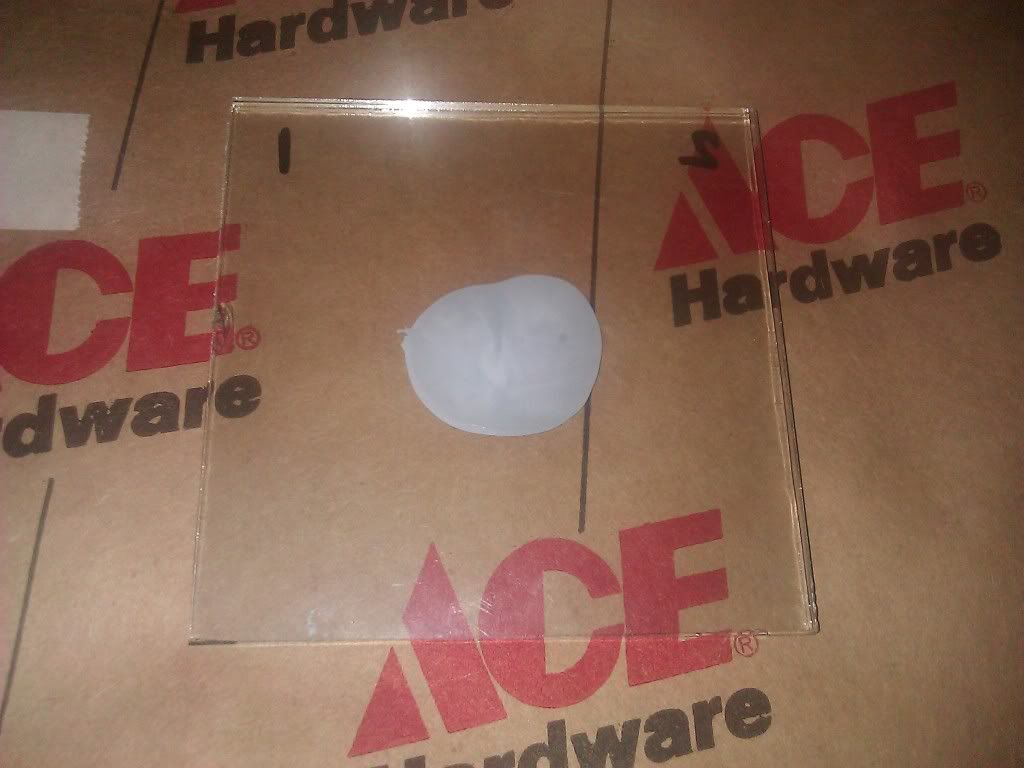 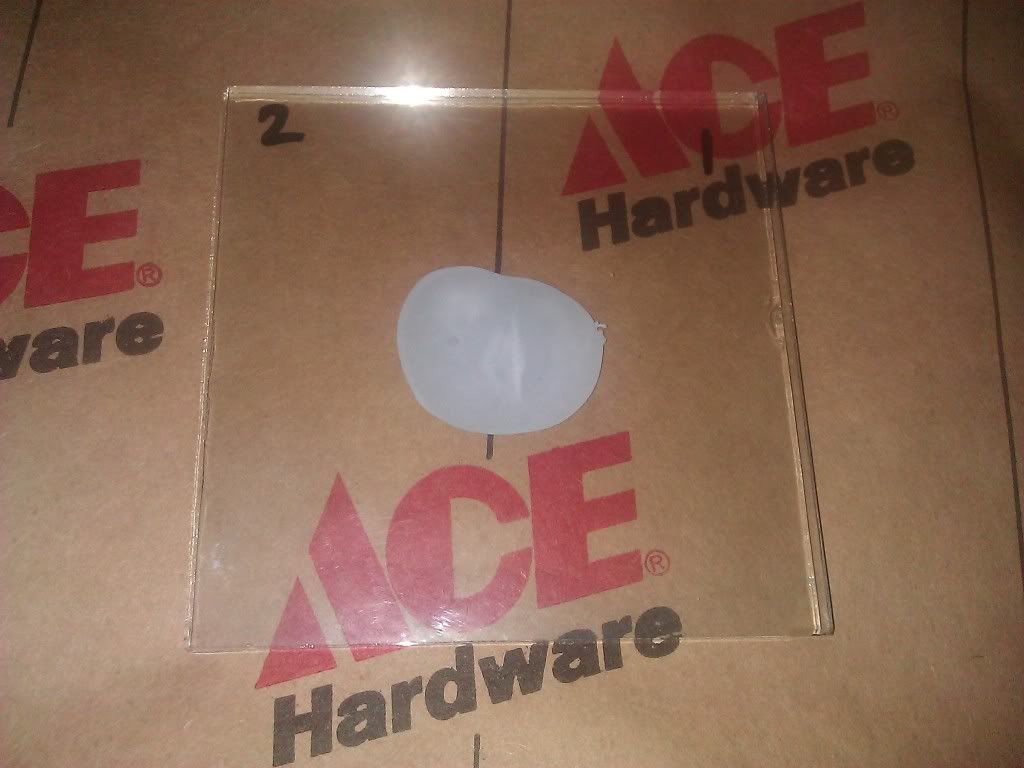 I cannot remember where or when I was reccomended the double line method, but I would not reccomend this to ANYONE. The coverage was not much better than the single line method but there was a MUCH thicker layer of TIM in between the two surfaces. That thick layer is going to cause more thermal resistance than any other method tested. And if you look at the spread-out side 2, the TIM in the middle that is still very light never mixes like the methods did. Which tells me that there was so much TIM in the center of the spread that even twisting the glass with pressure was not thinning it out. Manually Spreading out the TIM Quantity reference 1 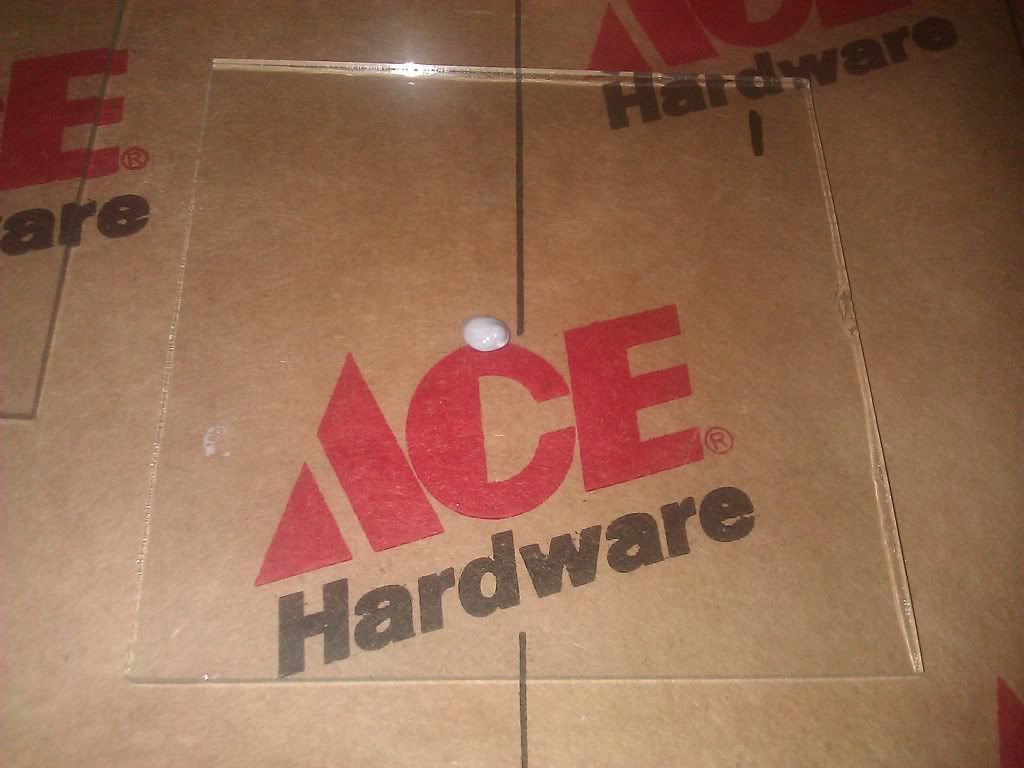 Video of Spreading 1 Quantity reference 2 Video of Spreading 1 Quantity reference 2 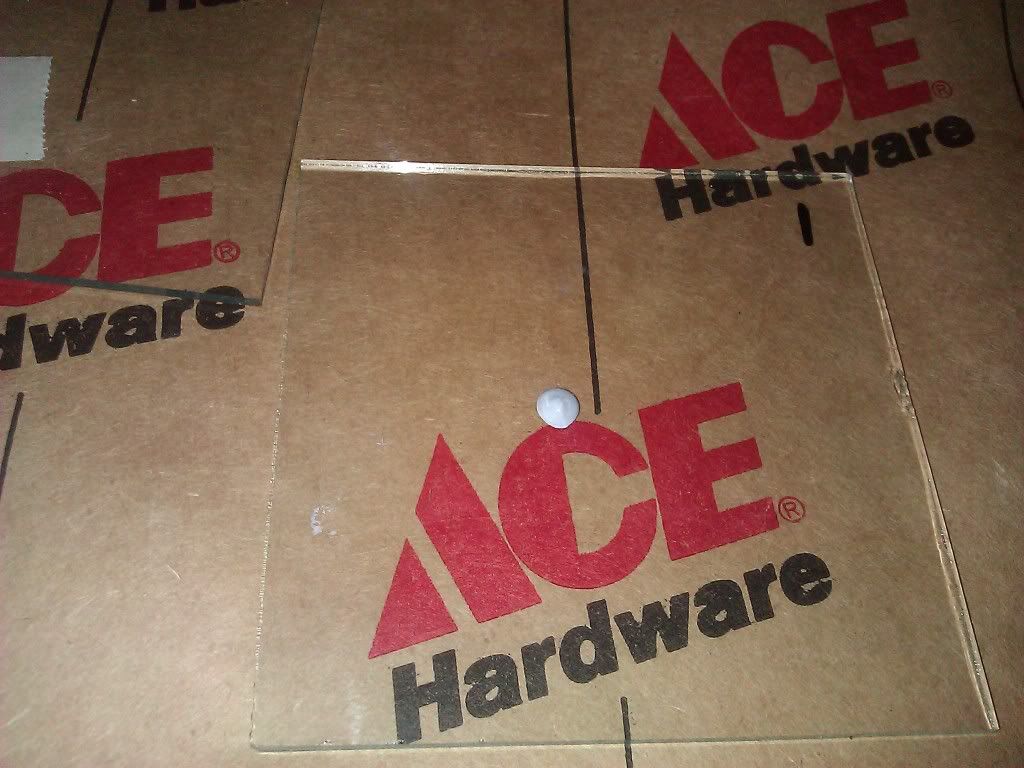 Video of Spreading 2 Video of Joining the Two Pieces Spread-Out Both Sides (Spread 2) Video of Spreading 2 Video of Joining the Two Pieces Spread-Out Both Sides (Spread 2) 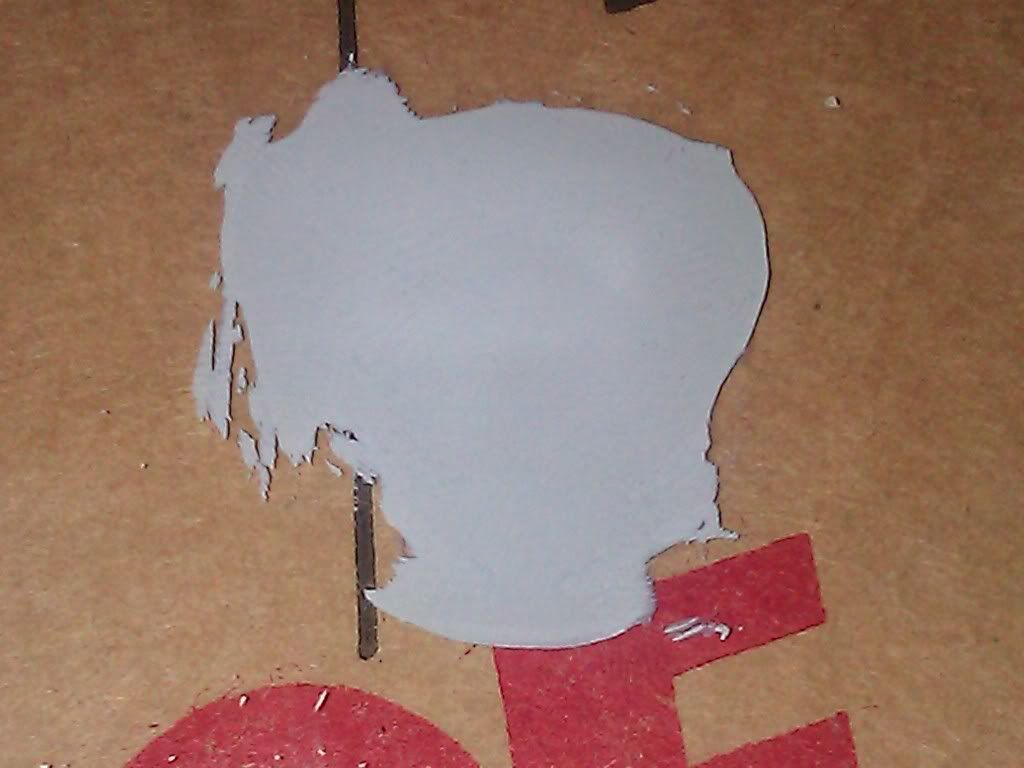  While the manual spread method doesnt look as clean as the pressure spread it felt about as good as the Pea-Sized Method as for material thickness. The only thing that worries me about this method is that I dont know if there is any air trapped beneath, and I dont know how well it will even out and spread. If you notice, no matter how much pressure I put on the moving glass, the TIM nearly refuses to spread out to fill gaps. While i was able to get the TIM to cover the entire Die area, I personally will not use this method again. Thinning with Alcohol Quantity Reference 1 Video of Mixing the first Video of Joining the two Pieces This was such a bad idea I had to do it twice just to make sure the results were justified Quantity reference video Video of Joining the Two Pieces Before the plates were seperated 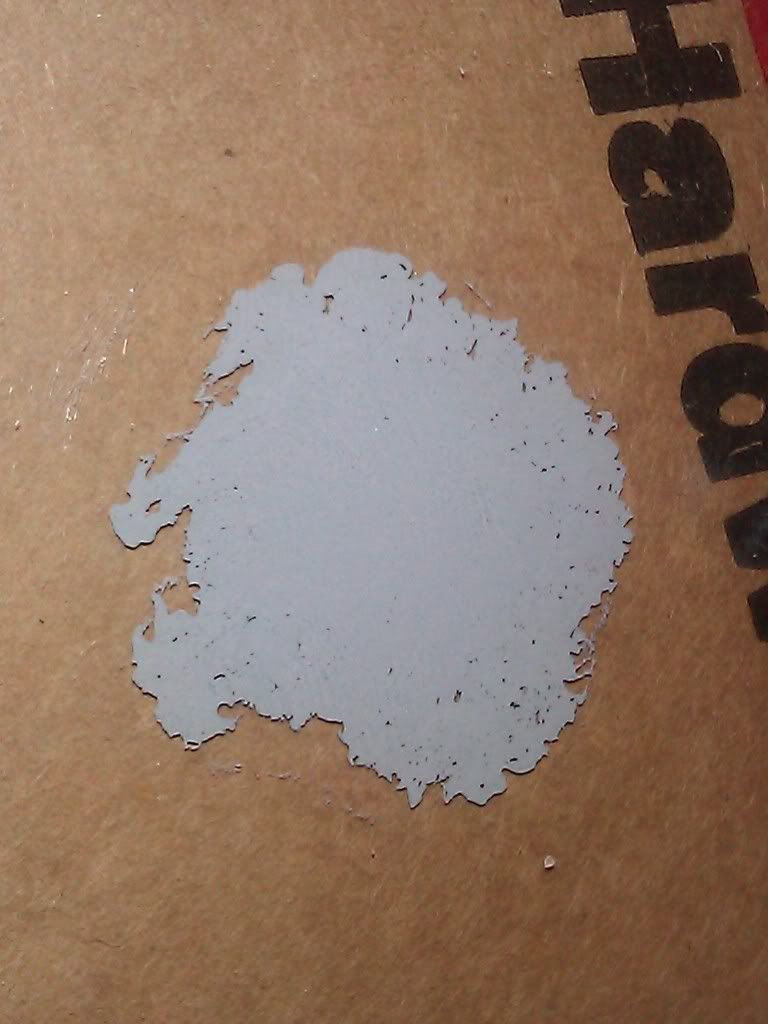  After the plates were seperated After the plates were seperated 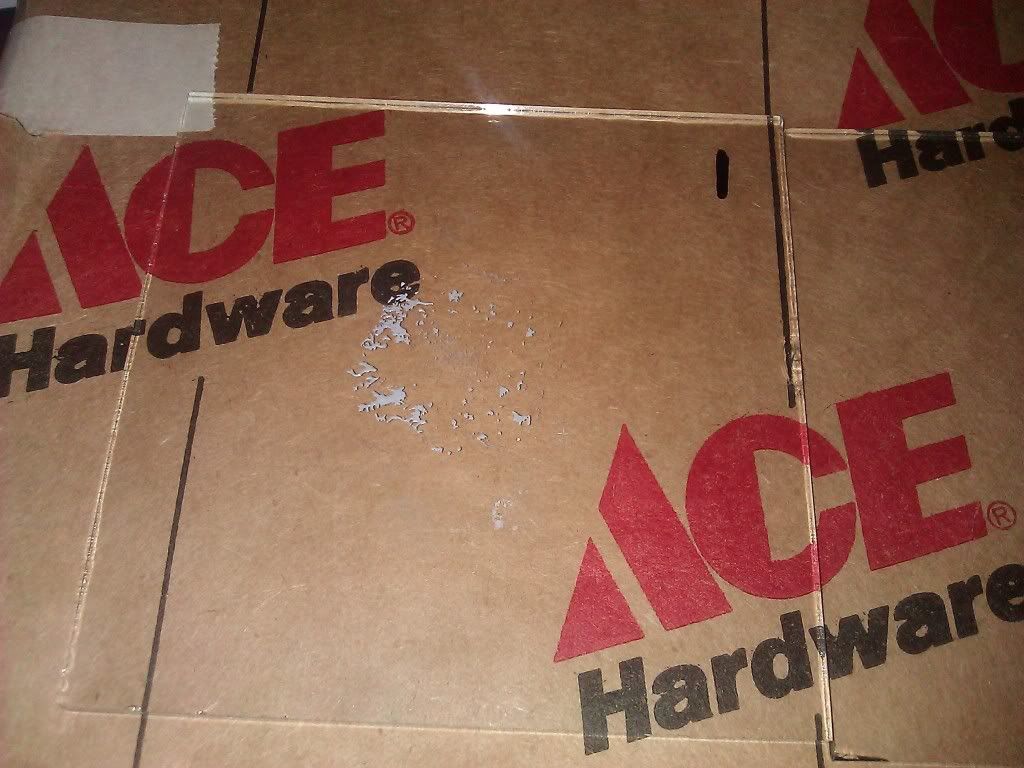 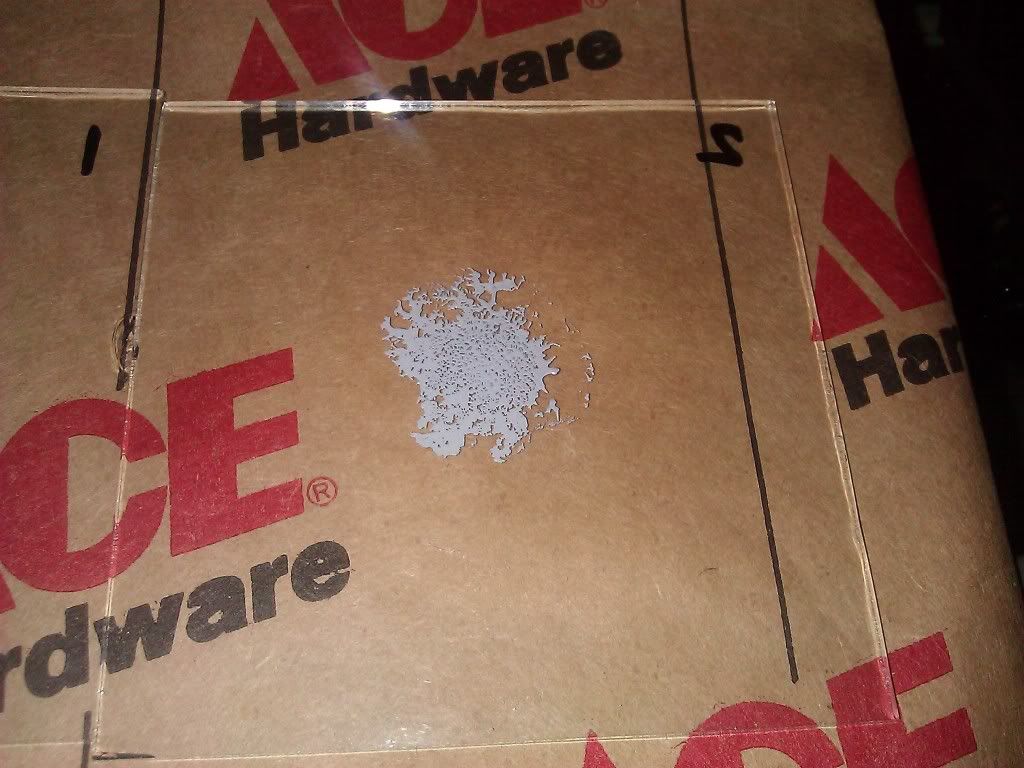 Well that answers the questions we had about thinning it with Alcohol. In other words NO. But in form: I would not reccommend this method to anyone for any reason. The TIM spreads unevenly and actually creates air bubbles within. To the point where you can see the holes in the TIM. In retrospect I wish I would have put some heat on this to see if the alcohol would evaporate and leave me with a good junction, but I doubt it since there were giant air bubbles in it. Even after the alcohol was gone, there would still be residue. Anyway No. Ok, for my final thoughts: For miror finish lapped equipment, I firmly believe that the sweet spot lies somewhere between Rice Grain and Pea Size. Those were the only ones where the layer of TIM felt thin enough to justify it as "Good" to "Great". For Flat lapped equipment but not mirrored I would highly suggest the Pea Sized method with tinting prior to application. If you dont know, Tinting is taking a small amount of TIM and rubbing it over the surfaces VERY THIN but completely. I tint with a coffee filter and 1/2 a grain of rice of TIM. I really hope everyone finds this as informative as I did doing it, and I would suggest this project to anyone because there is a DISTICT feel when the pieces have a nice thin layer of TIM. Now i doubt you'd be able to feel this with anything other than a WC Block in hand, but you can get a good feel for how much TIM belongs. Well that answers the questions we had about thinning it with Alcohol. In other words NO. But in form: I would not reccommend this method to anyone for any reason. The TIM spreads unevenly and actually creates air bubbles within. To the point where you can see the holes in the TIM. In retrospect I wish I would have put some heat on this to see if the alcohol would evaporate and leave me with a good junction, but I doubt it since there were giant air bubbles in it. Even after the alcohol was gone, there would still be residue. Anyway No. Ok, for my final thoughts: For miror finish lapped equipment, I firmly believe that the sweet spot lies somewhere between Rice Grain and Pea Size. Those were the only ones where the layer of TIM felt thin enough to justify it as "Good" to "Great". For Flat lapped equipment but not mirrored I would highly suggest the Pea Sized method with tinting prior to application. If you dont know, Tinting is taking a small amount of TIM and rubbing it over the surfaces VERY THIN but completely. I tint with a coffee filter and 1/2 a grain of rice of TIM. I really hope everyone finds this as informative as I did doing it, and I would suggest this project to anyone because there is a DISTICT feel when the pieces have a nice thin layer of TIM. Now i doubt you'd be able to feel this with anything other than a WC Block in hand, but you can get a good feel for how much TIM belongs. And thanks for looking! EDIT: Forgot to add detail pics of alcohol thinned after spread out
post edited by ChristoJ - 2011/07/21 12:47:15
|
kody7839
CLASSIFIED Member

- Total Posts : 3132
- Reward points : 0
- Joined: 2011/02/01 17:15:29
- Location: Affiliate Code: 7P5KPZC7F5
- Status: offline
- Ribbons : 17


Re:TIM Application Methods (Bandwidth Warning)
2011/07/20 21:11:02
(permalink)
Very nice, great post.
Thanks for taking the time to make the videos as well. This will help people to see the various ways often discussed.
My computer finds cures for diseases and searches for aliens when I'm not gaming...what does yours do? Ryzen 1700, ASRock Fatal1ty X370 Professional, EVGA GTX1080Ti FTW3, 16GB Corsair LPX, Noctua D14, EVGA SuperNOVA 650 P2, Overlord Tempest X270X Glossy, LG 34UM94 Ultrawide
|
chrisj4040
FTW Member

- Total Posts : 1075
- Reward points : 0
- Joined: 2010/10/19 19:32:40
- Location: Arkansas (Why yes! We do have computers.)
- Status: offline
- Ribbons : 7


Re:TIM Application Methods (Bandwidth Warning)
2011/07/20 21:14:39
(permalink)
ChristoJ, Great information! Very through comparison. Can't wait to start my laping project but I would be out of TIM  EDIT: Grats on the BR. Well earned 
post edited by chrisj4040 - 2011/07/20 21:23:07
 Huginn Huginn -Asus P6T7 Supercomputer - core i7-950 @ 4.0 GHz - 3x4GB Corsair Dominator 1600C9 - Crucial C300 128 GB SSD - Corsair X128 128 GB SSD - 2x 1TB WD Caviar Black HDD - 3Way SLI eVGA GTX 480 Superclocked+ - Corsair H70 - Corsair AX1200 PSU - Thermaltake Armor+
|
XrayMan
Insert Custom Title Here

- Total Posts : 63846
- Reward points : 0
- Joined: 2006/12/14 22:10:06
- Location: Santa Clarita, Ca.
- Status: offline
- Ribbons : 115


Re:TIM Application Methods (Bandwidth Warning)
2011/07/20 21:21:23
(permalink)
Very nice post indeed. Thank you for taking the time to put this together. Will help many people! BTW, here is your 1st BR! Good Job!!!! 
My Affiliate Code: 8WEQVXMCJL Associate Code: VHKH33QN4W77V6A   
|
ChristoJ
Superclocked Member

- Total Posts : 225
- Reward points : 0
- Joined: 2011/03/06 11:57:36
- Status: offline
- Ribbons : 1


Re:TIM Application Methods (Bandwidth Warning)
2011/07/20 21:25:10
(permalink)
Ty very much for the BR!!!!! There are a few more to come. I'm leaving the best one for last. Updating as i go so I dont lose any work. Storm here.
|
naokiura
iCX Member

- Total Posts : 376
- Reward points : 0
- Joined: 2007/05/04 14:56:13
- Status: offline
- Ribbons : 1

Re:TIM Application Methods (Bandwidth Warning)
2011/07/21 01:21:41
(permalink)
Nice vids, and I believe your right with the spread method that there is a lot of air gaps within the spread itself. Due to the uneven pressure when the heat sink is applied to the surface.
x299 Dark, i9-7920x, Corsair 3600 C18 32Gb, Corsair 1200AX, RTX 2080Ti FTW3 Ultra Hydro Copper, 2 - Samsung Evo Plus 1TB m.2
|
chrisj4040
FTW Member

- Total Posts : 1075
- Reward points : 0
- Joined: 2010/10/19 19:32:40
- Location: Arkansas (Why yes! We do have computers.)
- Status: offline
- Ribbons : 7


Re:TIM Application Methods (Bandwidth Warning)
2011/07/21 17:39:05
(permalink)
ChristoJ,
Amazing work regarding the thinned TIM. So much for creating a method to deliver an uber thin layer that way. It almost looks like the alcohol caused the TIM to be chemically altered to where it has more of an affinity for itself than the glass hence the clumping like effect. Like you said, bad idea! Great video though.
 Huginn Huginn -Asus P6T7 Supercomputer - core i7-950 @ 4.0 GHz - 3x4GB Corsair Dominator 1600C9 - Crucial C300 128 GB SSD - Corsair X128 128 GB SSD - 2x 1TB WD Caviar Black HDD - 3Way SLI eVGA GTX 480 Superclocked+ - Corsair H70 - Corsair AX1200 PSU - Thermaltake Armor+
|
SatchelF
Superclocked Member

- Total Posts : 158
- Reward points : 0
- Joined: 2011/01/31 19:18:38
- Status: offline
- Ribbons : 0


Re:TIM Application Methods (Bandwidth Warning)
2011/08/04 09:52:01
(permalink)
Great post!, Always wondered :D
 +1 My Rig If I Helped :D +1 My Rig If I Helped :D
|
RedCell141
Superclocked Member

- Total Posts : 115
- Reward points : 0
- Joined: 2011/06/09 22:20:42
- Location: Under your sisters bed
- Status: offline
- Ribbons : 0

Re:TIM Application Methods (Bandwidth Warning)
2011/12/01 16:14:12
(permalink)
Ill stick to the singal line method 
MOBO Sabertooth Z-77 CPU i-7 3770K @4.25GHz EVGA GTX 970 SC @(stock)1165MHz Gpu Boost(stock) 1317MHz PSU Cool Master silent pro 700w SSDSamsung 840 Evo 250 Gigs HDD WD Black Caviar 1TB, and WD 580GB8Gigs of DDR3RAM@ 1866MHz 
|
Hillguy
FTW Member

- Total Posts : 1321
- Reward points : 0
- Joined: 2008/10/05 06:17:13
- Location: Newfoundland
- Status: offline
- Ribbons : 10


Re:TIM Application Methods (Bandwidth Warning)
2011/12/03 14:29:24
(permalink)
A friend of mine sent me this link a long time ago , ever since I've used his Cross or X method at the end of the video. I especially like how he shows the even spread method creates more air pockets than any other possible way to do it.  http://www.youtube.com/watch?v=EyXLu1Ms-q4 http://www.youtube.com/watch?v=EyXLu1Ms-q4
eVGA RTX 3090 Kingpin Hydrocopper | eVGA X299 Dark | Intel i9 10980XE | Heatkiller IV CPU Block | 32 GB GSkill Trident Z 3200 | 500GB Samsung 860 Evo | Dual Corsair AX1200i PSU's | Dual Koolance RP-1000 Pumps | Dual Koolance EHX-1320 4x120mm Rads | W10 | Asus PB278Q | Acer 20" | Razer Death Stalker | Razer Death Adder | Thermaltake Armor+
|
RedCell141
Superclocked Member

- Total Posts : 115
- Reward points : 0
- Joined: 2011/06/09 22:20:42
- Location: Under your sisters bed
- Status: offline
- Ribbons : 0

Re:TIM Application Methods (Bandwidth Warning)
2011/12/04 07:16:58
(permalink)
Seems like X works well 
MOBO Sabertooth Z-77 CPU i-7 3770K @4.25GHz EVGA GTX 970 SC @(stock)1165MHz Gpu Boost(stock) 1317MHz PSU Cool Master silent pro 700w SSDSamsung 840 Evo 250 Gigs HDD WD Black Caviar 1TB, and WD 580GB8Gigs of DDR3RAM@ 1866MHz 
|
jingiko
FTW Member

- Total Posts : 1258
- Reward points : 0
- Joined: 2009/02/04 22:17:42
- Location: New York City
- Status: offline
- Ribbons : 5

Re:TIM Application Methods (Bandwidth Warning)
2011/12/13 16:43:36
(permalink)
Interesting, I always used the spread method but the X method does seem to be the best.
Didn't think about the air pockets if I do the spread method. And Ive been using that method for years! D:
|
buggyruth
FTW Member

- Total Posts : 1080
- Reward points : 0
- Joined: 2011/08/29 16:57:57
- Status: offline
- Ribbons : 3


Re:TIM Application Methods (Bandwidth Warning)
2011/12/17 02:43:50
(permalink)
I have never heard of the x method. Looks like it works very well. 
+1 If you like my Mods-Rig http://www.heatware.com/eval.php?id=78759 COOLER MASTER HAF X RC-942-KKN1 / EVGA Z77-FTW / Intel I7-3770K / 2 X Corsair Force Series GT 240GB. SSD Raid-0 / Western Digital Caviar Black WD2002FAEX / G.SKILL Trident X Series F3-2400C10D-16GTX / 2 X EVGA GeForce GTX 670-FTW+4GB. (04G-P4-3673-KR) with EK GeForce 680 GTX VGA Liquid Cooling Blocks - Acetal CSQ (EK-FC680 GTX - Acetal CSQ) / Swiftech Maelstrom 51/4" dual bay reservoir with dual MCP35X pumps / RayStorm CPU WaterBlock (Intel) Copper / XSPC RX360 Rad & XSPC EX140
|
lastsamurairick
FTW Member

- Total Posts : 1708
- Reward points : 0
- Joined: 2008/11/11 17:19:53
- Location: Orlando,FL
- Status: offline
- Ribbons : 6


Re:TIM Application Methods (Bandwidth Warning)
2012/01/07 07:24:36
(permalink)
Intel 10900k @ 3.7 Stock EVGA Z490 Dark EVGA GEFORCE RTX 3070Ti FTW3 G SKILL TRIDENT Z ROYAL 32GB EVGA 1000G5
|
KaptCrunch
Superclocked Member

- Total Posts : 126
- Reward points : 0
- Joined: 2010/07/10 09:35:00
- Status: offline
- Ribbons : 1

Re:TIM Application Methods (Bandwidth Warning)
2012/01/10 05:54:01
(permalink)
for me the Happy Face works best
good show
|
wumpus
New Member

- Total Posts : 34
- Reward points : 0
- Joined: 2010/08/12 19:09:49
- Status: offline
- Ribbons : 0

Re:TIM Application Methods (Bandwidth Warning)
2012/01/15 23:01:50
(permalink)
very informative man!
you might want to test out spreading on bigger dies like on the nvidia cards....those are hard to get completely covered.
|
pakiefarkas
Superclocked Member

- Total Posts : 238
- Reward points : 0
- Joined: 2007/07/23 12:17:28
- Status: offline
- Ribbons : 1


Re:TIM Application Methods (Bandwidth Warning)
2013/09/19 08:16:26
(permalink)
|
seth89
CLASSIFIED Member

- Total Posts : 4420
- Reward points : 0
- Joined: 2007/11/13 11:26:18
- Status: offline
- Ribbons : 14


Re:TIM Application Methods (Bandwidth Warning)
2014/02/23 13:51:44
(permalink)
my ek water block for a GPU told me to X like the British flag. Is that because the die is so big?
|
rjbarker
CLASSIFIED Member

- Total Posts : 2361
- Reward points : 0
- Joined: 2008/03/20 10:07:05
- Location: Vancouver Isle - Westcoast Canada
- Status: offline
- Ribbons : 21


Re:TIM Application Methods (Bandwidth Warning)
2014/06/03 14:29:16
(permalink)
Just stumbled across this.....funny how the method "rice grain" size hasnt changed even though CPU's have gotten wayyyyyyyy bigger!! Its obvious a Rice Grain size is not enough and will result in a fairly substantial part of the Chip being bare of TIM......I used to use pea size on my 1366 and now have gone to the line method on my 2011 Chip!
I9 12900K EK Velocity2 / ROG Z690 Apex/ 32G Dominator DDR5 6000/ Evga RTX 3080Ti FTW3 EK Vector / 980 Pro 512G / 980 Pro 1TB/ Samsung 860 Pro 500G/ WD 4TB Red / AX 1600i / Corsair 900D & XSPC 480 * 360 * 240 Rads XSPC Photon 170 Rez-Vario Pump Combo - Alienware 3440*1440p 120Hz/ W11
|
HayzBaby
iCX Member

- Total Posts : 483
- Reward points : 0
- Joined: 2010/05/04 13:06:31
- Status: offline
- Ribbons : 4


Re:TIM Application Methods (Bandwidth Warning)
2014/06/26 19:57:38
(permalink)
Somebody had a visual diagram of the difference between intel and amd chips. Ones concave and the other is convex. I believe that would effect tim application as well. ie using more or less based on the chip being used. Its also a slight misconception on the actual spread of our tims on said parts, cpu or gpu. We may not get the same results due to us not being able to apply as much pressure as you did on the two pieces of glass, or not knowing how much is enough to get spread. Sure, you could try the pea method, put your parts together, run it a few days, then pull it back off to check spread then reapply.
You would have figured somebody would have tested which amount is close to perfect without having excess, then just sell that exact amount per chip, cpu or gpu respectively
|
outhouse
iCX Member

- Total Posts : 349
- Reward points : 0
- Joined: 2008/08/09 20:23:15
- Status: offline
- Ribbons : 3


Re:TIM Application Methods (Bandwidth Warning)
2014/06/26 20:07:36
(permalink)
One not overthink the whole show here.
The key is getting a good compound, apply and enjoy.
I7 4790K @ 4.8, EVGA FTW, 16g Corsair vengance pro, 250 SSD sumsung evo, GTX 780ti SLI, Corsair HX1050, BENQ XL2720Z.
|
rjbarker
CLASSIFIED Member

- Total Posts : 2361
- Reward points : 0
- Joined: 2008/03/20 10:07:05
- Location: Vancouver Isle - Westcoast Canada
- Status: offline
- Ribbons : 21


Re:TIM Application Methods (Bandwidth Warning)
2014/06/27 12:30:16
(permalink)
^^^ Exactly.......which TIM is best..which method is best..too little ..too much....all "over thought"....think I have about 4 tubes of grease presently in my tool box....I always seem to select whichever one is opened ...so I dont have 3 opened tubes of grease going ;)
I9 12900K EK Velocity2 / ROG Z690 Apex/ 32G Dominator DDR5 6000/ Evga RTX 3080Ti FTW3 EK Vector / 980 Pro 512G / 980 Pro 1TB/ Samsung 860 Pro 500G/ WD 4TB Red / AX 1600i / Corsair 900D & XSPC 480 * 360 * 240 Rads XSPC Photon 170 Rez-Vario Pump Combo - Alienware 3440*1440p 120Hz/ W11
|
JoeBroniee
New Member

- Total Posts : 51
- Reward points : 0
- Joined: 2013/12/04 17:26:12
- Location: Sacramento, CA
- Status: offline
- Ribbons : 0

Re:TIM Application Methods (Bandwidth Warning)
2014/10/05 01:36:52
(permalink)
Ncase M1, Asus M6impact intel i5 4690k HyperX Genesis EVGA GTX770 Silverstone sx600g Samsung 840EVO
|
blgraeber
New Member

- Total Posts : 8
- Reward points : 0
- Joined: 2013/04/24 11:40:47
- Status: offline
- Ribbons : 0

Re:TIM Application Methods (Bandwidth Warning)
2014/12/09 10:23:58
(permalink)
Great review, thanks man.
|
bkhan530
Superclocked Member

- Total Posts : 105
- Reward points : 0
- Joined: 2013/03/20 17:58:32
- Location: Scottsdale, Arizona
- Status: offline
- Ribbons : 1

Re:TIM Application Methods (Bandwidth Warning)
2015/01/15 01:10:32
(permalink)
I've always gone w/a single line on GPUs and it's worked out quite well. Nice job OP.
|
Nereus
Captain Goodvibes

- Total Posts : 18192
- Reward points : 0
- Joined: 2009/04/09 20:05:53
- Location: Brooklyn, NYC.
- Status: offline
- Ribbons : 58


Re:TIM Application Methods (Bandwidth Warning)
2015/02/16 19:57:02
(permalink)
Thanks for that great demos ChristoJ. I always do the 'tinting', although my method is covering a finger in gladwrap and then rubbing an almost invisible layer of TIM on both surfaces. I usually use the spreader method after that, using a thin credit card to spread the TIM (actually it's one of my medical insurance cards, which is a lot thinner than a standard credit card). Seems to work well every time for me. After viewing your demos, I might try a slightly elongated pea size next time and see how that goes. Certainly easier than spreading with a card. Just an additional note; the type of TIM used can make quite a difference to the application method used. I was a regular user of one of the Shin-Etsu pastes a few years back, and while it had very good conductivity, the stuff was tacky and hard to apply, and that is when I started using the spreader method because the pea or rice grain method didn't always spread fully or evenly with the tackier TIM, even after a solid break-in period (meaning a good number of hours blasting Prime95). Last couple of years I've been using Arctic MX-4, which is a lot more forgiving to work with, so I think the pea method may work well with this thinner TIM. Cheers.
post edited by Nereus - 2015/02/16 20:01:48
|
MattyMattMatt
Superclocked Member

- Total Posts : 112
- Reward points : 0
- Joined: 2015/07/28 13:50:17
- Location: Edmonton Area, AB
- Status: offline
- Ribbons : 0

Re:TIM Application Methods (Bandwidth Warning)
2015/08/03 15:37:48
(permalink)
 Associate Code: C0RZOAF57R3JE6B Elite Member ID: MXFACO40E1XPINUAY3X
|
Gawg36
iCX Member

- Total Posts : 376
- Reward points : 0
- Joined: 2016/07/28 15:58:52
- Location: Japan (Work) U.K (home)
- Status: offline
- Ribbons : 1

Re:TIM Application Methods (Bandwidth Warning)
2016/12/10 07:50:01
(permalink)
Thanks OP for the post and great pics etc. Very interesting indeed. Must have taken quite a bit of time to put all that together and post in a clear, interesting, accurate way.
1. Taichi z370. i7 8086k @ 5,2GHz Stable. 16GB G.Skill Trident Z @ 3,000MHz. EVGA GTX 1080ti FTW3. Acer XB270HU IPS 1440p 144Hz Refresh with G-Sync. PSU Corsair AX850. Cloud two cans, and Creative T20 stereo. Realtek HD on board sound.
|
aka_STEVE_b
EGC Admin

- Total Posts : 13835
- Reward points : 0
- Joined: 2006/02/26 06:45:46
- Location: OH
- Status: offline
- Ribbons : 69


Re:TIM Application Methods (Bandwidth Warning)
2016/12/12 11:30:33
(permalink)
I have always done the pea sized amount depending on the size of the die I was working with and it has treated me well over many years.
AMD RYZEN 9 5900X 12-core cpu~ ASUS ROG Crosshair VIII Dark Hero ~ EVGA RTX 3080 Ti FTW3~ G.SKILL Trident Z NEO 32GB DDR4-3600 ~ Phanteks Eclipse P400s red case ~ EVGA SuperNOVA 1000 G+ PSU ~ Intel 660p M.2 drive~ Crucial MX300 275 GB SSD ~WD 2TB SSD ~CORSAIR H115i RGB Pro XT 280mm cooler ~ CORSAIR Dark Core RGB Pro mouse ~ CORSAIR K68 Mech keyboard ~ HGST 4TB Hd.~ AOC AGON 32" monitor 1440p @ 144Hz ~ Win 10 x64
|
EVGATech_GabrielT
EVGA Tech Support

- Total Posts : 1104
- Reward points : 0
- Joined: 2012/02/22 09:59:37
- Status: offline
- Ribbons : 1

Re:TIM Application Methods (Bandwidth Warning)
2018/10/29 01:24:58
(permalink)
Great information and post. 
|